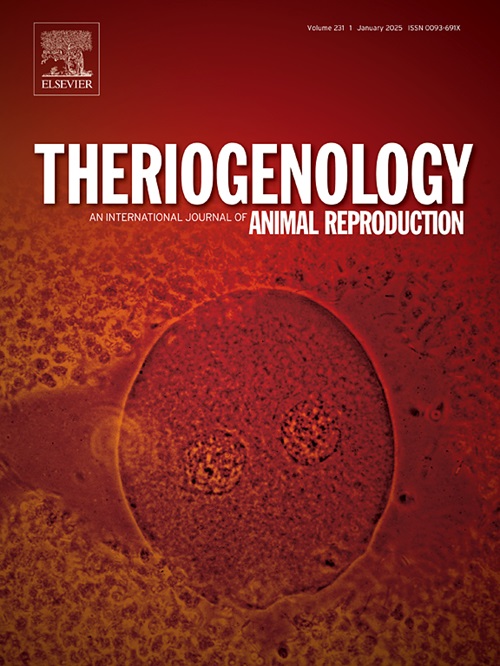Ascorbic acid and resveratrol improve the structural integrity of the extracellular matrix and enhance follicular survival in cultured bovine ovarian tissue
IF 2.4
2区 农林科学
Q3 REPRODUCTIVE BIOLOGY
引用次数: 0
Abstract
This study aimed to investigate the changes induced by the culture system and the effect of ascorbic acid and resveratrol on collagen fibers, stromal cells, follicle growth and survival, as well as antioxidant enzyme activity in cultured bovine ovarian tissues. In experiment 1, bovine ovarian fragments were cultured in α-minimum essential medium (α-MEM+) for 6 days. Before and after culturing, the fragments were fixed and processed to assess follicular morphology and diameters, stromal cell survival, collagen fibers, and glycosaminoglycans (GAGs). Uncultured and cultured tissues were also used to measure mRNA expression for superoxide dismutase (SOD), catalase (CAT), glutathione peroxidase (GPX), and peroxiredoxin (PRDX). Thiol levels and activity of CAT, SOD, and GPX enzymes were also investigated. In experiment 2, bovine ovarian fragments were cultured in α-MEM+ alone or supplemented with 50 μg/mL ascorbic acid or both 50 μg/mL ascorbic acid and 20 μM resveratrol for 6 days. In experiment 1, cultured tissues had higher percentages of growing follicles, but higher percentage of degenerated follicles than uncultured slices (P < 0.05). Additionally, the collagen and GAGs network became disorganized, with reduced deposition around primordial and primary follicles (P < 0.05). The number of stromal and granulosa cells, as well as follicular and oocyte diameters were reduced in both follicular categories compared to uncultured tissue (P < 0.05). Expression of mRNA for CAT, SOD, GPX, and PRDX was downregulated in 6-day cultured tissues (P < 0.05). Similarly, thiol levels and CAT activity were also reduced (P < 0.05). In experiment 2, ascorbic acid or both ascorbic acid and resveratrol increased the rate of follicular diameters and survival, and the number of granulosa and stromal cells compared to tissues cultured in the control medium (P < 0.05). Both ascorbic acid and resveratrol improved collagen density and preserved the GAG network, as well as increased thiol levels and CAT activity (P < 0.05). In conclusion, in vitro culture of ovarian tissue favored follicular activation, but reduced the proportion of normal follicles, collagen, GAG network, stromal cell numbers, and tissue antioxidant protection. Ascorbic acid alone or in association with resveratrol improved the preservation of extracellular matrix components and enhanced follicular survival.
求助全文
约1分钟内获得全文
求助全文
来源期刊

Theriogenology
农林科学-生殖生物学
CiteScore
5.50
自引率
14.30%
发文量
387
审稿时长
72 days
期刊介绍:
Theriogenology provides an international forum for researchers, clinicians, and industry professionals in animal reproductive biology. This acclaimed journal publishes articles on a wide range of topics in reproductive and developmental biology, of domestic mammal, avian, and aquatic species as well as wild species which are the object of veterinary care in research or conservation programs.
 求助内容:
求助内容: 应助结果提醒方式:
应助结果提醒方式:


